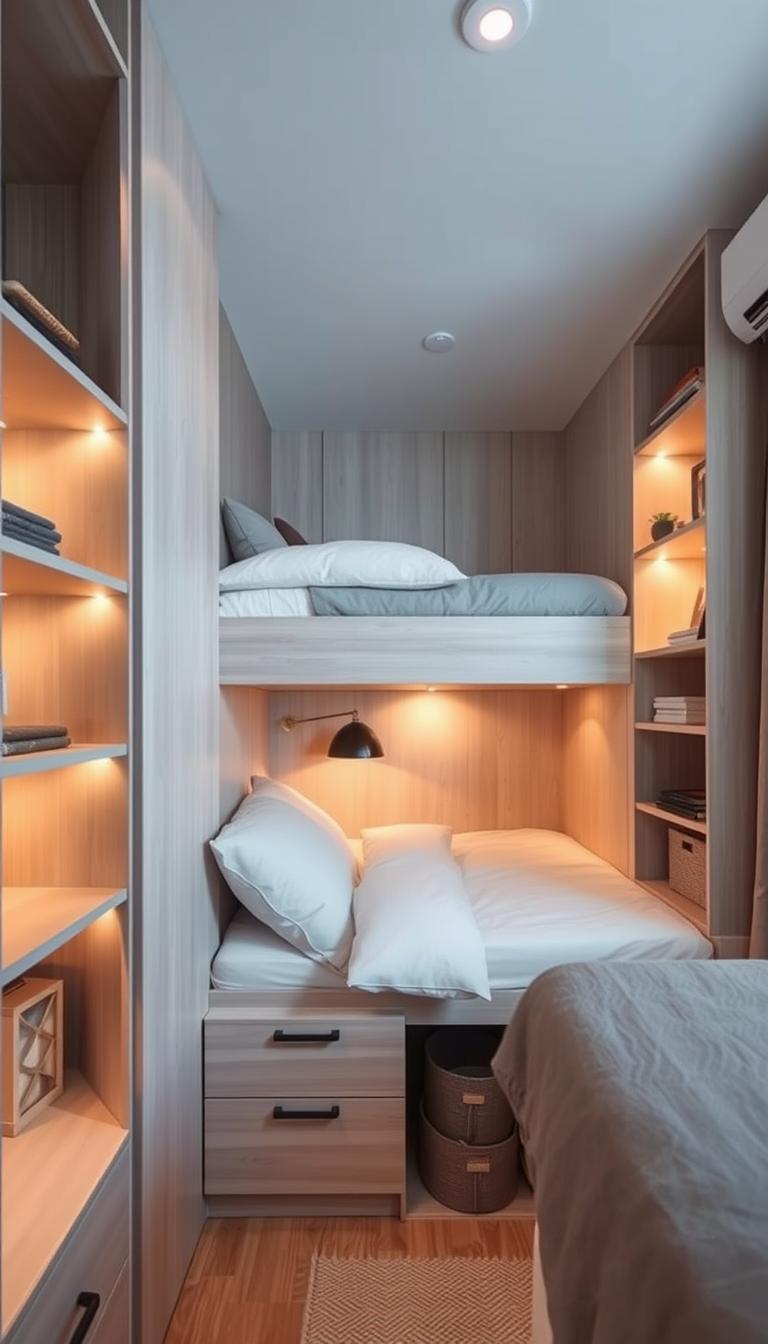When I first moved into my cozy apartment, I quickly realized that making the most of limited space was both a challenge and an opportunity. A small bedroom doesn’t have to feel cramped or cluttered—it can be a sanctuary of comfort and style. Over time, I’ve discovered that with the right approach, even the tiniest areas can feel spacious and inviting.
In this article, I’ll share 15 practical tips to help you transform your compact bedroom into a functional and stylish retreat. From multifunctional furniture to clever layout planning, each suggestion is designed to maximize your space without sacrificing aesthetics. I’ve also included insights from interior experts like Downing and Press to ensure you’re getting tried-and-true advice.
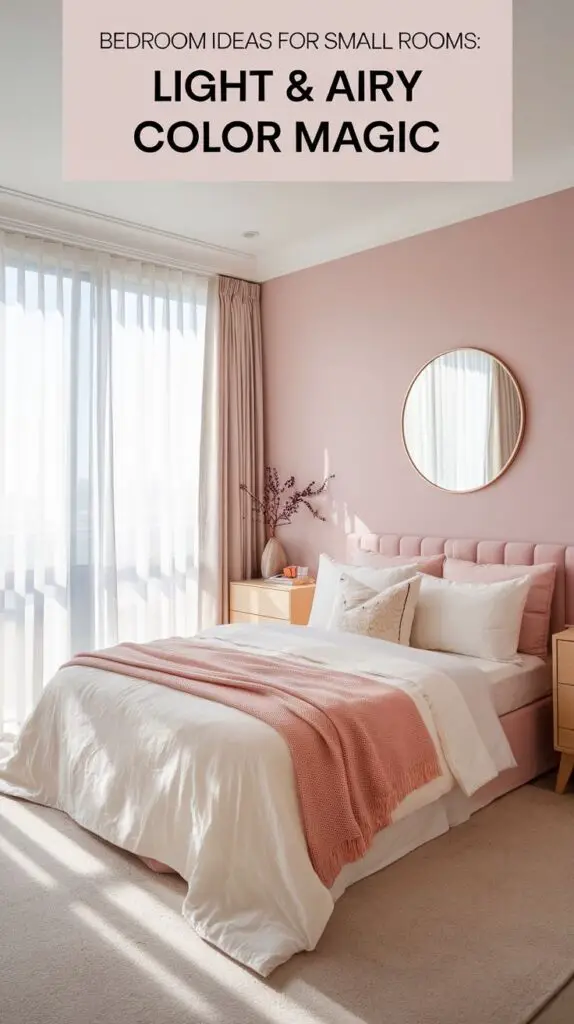
To make navigation easy, the article is divided into clear sections, covering everything from lighting and color choices to storage solutions. Whether you’re starting from scratch or looking to refresh your current setup, this guide is here to inspire and empower you. Let’s turn your small bedroom into a place you’ll love spending time in!
Redesign any interior in just 30 seconds with this powerful AI software tool—turn your wildest decor dreams into photorealistic visions instantly. Try it now and watch your space transform ... Try This FREE AI design tool.
Key Takeaways
- Maximize space with multifunctional furniture.
- Use light colors to create an open and airy feel.
- Incorporate clever storage solutions to reduce clutter.
- Plan your layout to optimize every inch of your bedroom.
- Experiment with lighting to enhance the room’s ambiance.
Setting the Stage for Small Bedroom Transformations
Transforming a compact area starts with understanding its unique challenges. Before diving into design, it’s crucial to assess the space you’re working with. This step ensures that every decision, from furniture placement to storage solutions, maximizes functionality and style.
Understanding Your Space Limitations
Begin by measuring your room’s dimensions. Note the placement of windows, doors, and fixed walls. These elements will influence your layout choices. For example, a bed placed near a window can create a cozy nook, while bulky furniture might block natural light.
Consider the flow of movement. A well-planned layout ensures easy access to key areas like the closet or desk. Avoid overcrowding by choosing pieces that fit the scale of your room. Here's some ideas on furnishings.
Defining Your Style Goals
Your personal style plays a significant role in the design process. Do you prefer a minimalist look or a cozy, layered feel? Think about colors, textures, and patterns that resonate with you. For instance, light-colored walls can make a space feel larger, while bold accents add personality.
Balance functionality with aesthetics. A sleek, low-profile bed frame can save space without compromising style. Similarly, wall-mounted shelves keep clutter off the floor while adding visual interest.
| Element | Impact on Design |
|---|---|
| Windows | Influence natural light and furniture placement |
| Fixed Walls | Limit layout options but can be used creatively |
| Room Dimensions | Determine the size and scale of furniture |
By assessing your space and defining your style goals, you can create a room that’s both functional and beautiful. Clear headings like these make it easy to navigate the planning process, ensuring every detail is considered.
Bedroom Ideas For Small Rooms
Creative solutions are key to transforming tight spaces into functional zones. I’ve found that with a little ingenuity, even the most limited areas can feel open and organized. The secret lies in maximizing every inch while keeping the design streamlined and inviting.
One of my favorite storage hacks is repurposing a closet into a mini office. By removing the doors and adding a desk, shelves, and lighting, you can create a dedicated workspace without sacrificing precious floor space. This idea not only saves room but also adds functionality to an often underutilized area.
Another game-changer is using multipurpose furniture. For example, a sofa bed or a storage ottoman can serve dual purposes, making your home more versatile. Floating shelves are also a great way to keep clutter off the floor while adding visual interest to the walls.
Here are a few more ideas to inspire your design:
Redesign any interior in just 30 seconds with this powerful AI software tool—turn your wildest decor dreams into photorealistic visions instantly. Try it now and watch your space transform ... Try This FREE AI design tool.
- Use vertical space with tall bookshelves or wall-mounted organizers.
- Opt for furniture with built-in storage, like beds with drawers underneath.
- Incorporate foldable or stackable pieces that can be tucked away when not in use.
When planning your space, it’s important to keep the design cohesive. Choose pieces that match your style and avoid overcrowding. By carefully selecting each element, you can create a functional and stylish area that feels anything but cramped.
I encourage you to explore these ideas and adapt them to your needs. Whether it’s a closet office or a multifunctional piece of furniture, the right solution can make all the difference in your home.
Planning Your Layout for Optimal Flow
The key to a well-organized space lies in thoughtful arrangement and design. A smart layout not only maximizes functionality but also enhances the overall feel of the area. Let’s dive into actionable tips to create a seamless flow in your compact space.
Choosing a Functional Furniture Arrangement
Start by selecting pieces that fit the scale of your area. A bed frame with a low profile can save space while maintaining style. Daybeds or convertible pieces are excellent options for multipurpose use. For example, a daybed can serve as a sofa during the day and a bed at night.
Arrange your furniture to create clear pathways. Place larger items like the bed against the longest wall to free up floor space. Avoid blocking windows or doors, as this can make the area feel cramped. A well-planned layout ensures every inch is utilized effectively.
Utilizing Open Floor Space Effectively
Leaving open zones is crucial for movement and visual appeal. Avoid overcrowding by sticking to essential pieces. For instance, a minimalist desk or a compact nightstand can provide functionality without taking up too much room.
Incorporate multipurpose furniture to maximize utility. A storage ottoman or a foldable chair can serve dual purposes, keeping the area clutter-free. Remember, less is more when it comes to creating an open and airy feel.
By focusing on thoughtful arrangement and open zones, you can transform your space into a functional and stylish haven. Experiment with different layouts to find what works best for your needs.
Embracing Multifunctional Furniture Solutions
Multifunctional furniture is a game-changer for compact living spaces. It maximizes utility without compromising style, making it an essential choice for anyone looking to optimize their interior. I’ve found that pieces like storage beds and convertible designs can transform even the tiniest areas into functional and inviting zones.

“The right furniture can turn limitations into opportunities, creating a harmonious balance between form and function.”
This philosophy has guided my approach to selecting pieces that serve dual purposes, such as a bed with built-in drawers or a desk that doubles as anightstand.
Storage Beds and Convertible Pieces
Storage beds are a perfect example of multifunctional design. They offer ample space for linens, clothing, or other essentials, reducing the need for additional storage units. I’ve personally used a bed with drawers underneath, and it’s been a lifesaver for keeping my space clutter-free.
Convertible furniture, like sofa beds or foldable desks, is another smart choice. These pieces adapt to your needs, providing flexibility without taking up extra room. For instance, a foldable desk can serve as a workspace during the day and be tucked away at night, maintaining an open and airy feel.
Here are some key benefits of multifunctional furniture:
- Maximizes floor space, creating a more open interior.
- Reduces clutter by combining storage and functionality.
- Adds vertical interest, drawing the eye upward and enhancing the ceiling’s impact.
| Furniture Type | Benefits |
|---|---|
| Storage Beds | Built-in drawers for hidden storage |
| Convertible Desks | Foldable design saves space |
| Sofa Beds | Dual-purpose seating and sleeping |
By incorporating multifunctional furniture, you can create a cohesive and stylish interior that meets your needs. Whether it’s a storage bed or a convertible piece, these solutions ensure your space remains functional and beautiful.
Maximizing Vertical Space and Creative Wall Solutions
One of the most effective ways to make a compact area feel larger is by maximizing vertical space. When floor space is limited, looking upward can unlock a world of possibilities. I’ve found that using walls creatively not only declutters the area but also adds a unique aesthetic appeal.
Floating Shelves and Wall-Mounted Accessories
Floating shelves are a game-changer for small spaces. They provide storage without taking up valuable floor area. I’ve used them to display books, plants, and decorative items, creating a personalized touch. Placing frequently used items on lower shelves ensures easy access while keeping the space organized.
Wall-mounted accessories, like sconces or a lamp, can also enhance functionality. I installed a wall-mounted lamp above my desk, freeing up table space and adding a modern touch. These solutions not only save room but also draw the eye upward, making the area feel taller and more open.
Creative Ideas to Elevate Décor
Art frames and mirrors are excellent for adding visual interest. I’ve hung a gallery wall of frames to showcase my favorite photos and artwork. Mirrors, on the other hand, reflect light and create the illusion of depth, making the area feel more spacious.
Proper spacing is key to avoiding overcrowding. I recommend leaving enough room between items to maintain a light, airy feel. This approach ensures that the walls don’t look cluttered, enhancing the overall ambiance.
| Vertical Solution | Benefits |
|---|---|
| Floating Shelves | Save floor space, add storage and décor |
| Wall-Mounted Lamps | Free up table space, enhance lighting |
| Art Frames | Add personality and visual interest |
By embracing vertical solutions, I’ve transformed my compact area into a functional and stylish space. Whether it’s floating shelves or a wall-mounted lamp, these ideas can help you make the most of your small space.
Innovative Use of Headboards and Focal Points
A well-designed headboard can redefine the entire feel of a space, offering both style and functionality. In my experience, a creative headboard serves as the central focal point, instantly drawing attention and setting the tone for the room. Whether it’s an oversized statement piece or a functional design, the right headboard can transform even the most compact area into a stylish retreat.
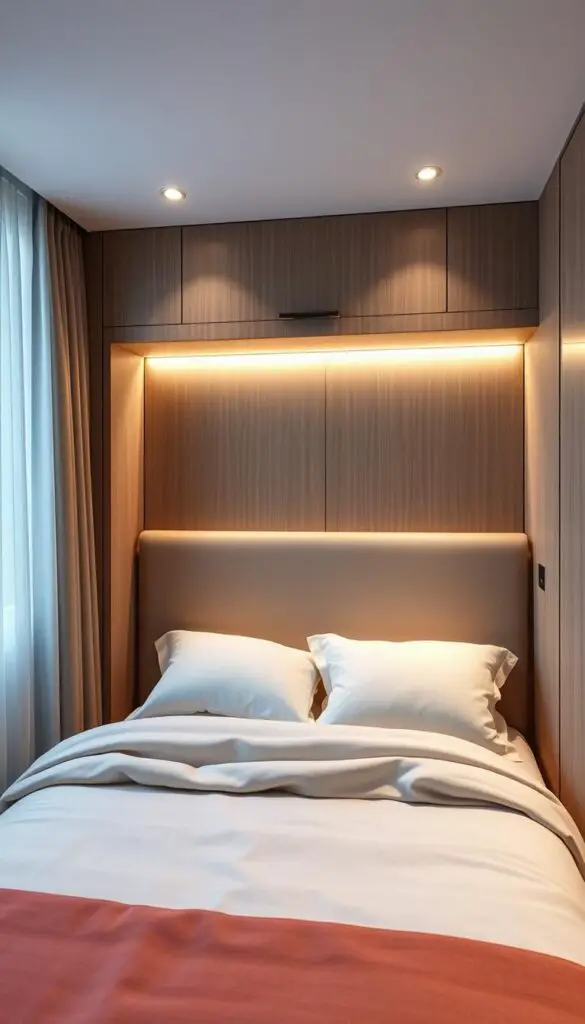
Extended Headboards to Enhance Depth
One of my favorite techniques is extending the headboard to visually widen the room. By stretching the headboard horizontally or vertically, you create the illusion of more space. I’ve seen designers use this approach to great effect, pairing oversized headboards with light-colored walls to amplify the sense of depth.
Another way to enhance the headboard’s impact is by incorporating functional elements. For example, I added a built-in table to my extended headboard, providing a convenient surface for books or a lamp. This not only saves space but also adds a practical touch to the design.
Creative Ideas for Headboard Design
Patterned headboards are another excellent way to add character. I’ve experimented with bold prints and textures, which instantly elevate the room’s aesthetic. For a cohesive look, I recommend matching the headboard’s design with other elements in the space, such as curtains or bedding.
Here are some additional ideas to inspire your headboard design:
- Use an oversized headboard as a statement piece to anchor the room.
- Incorporate storage compartments or shelves into the headboard for added functionality.
- Experiment with materials like wood, fabric, or metal to create a unique look.
| Headboard Type | Benefits |
|---|---|
| Extended Headboard | Creates the illusion of more space |
| Patterned Headboard | Adds visual interest and character |
| Functional Headboard | Incorporates storage or surfaces |
By focusing on innovative headboard designs, you can redefine the size and style of your space. Whether it’s an extended piece or a functional design, the right headboard can make a significant impact on the overall feel of the room.
Choosing the Perfect Bed Frame for a Cozy Look
Selecting the right bed frame can make or break the cozy feel of your space. It’s not just about aesthetics; the frame’s size, style, and functionality play a crucial role in creating a balanced design. I’ve learned that a well-chosen frame can transform even the most compact area into an inviting retreat.
One common mistake is choosing a bed that’s too large for the area. Oversized frames can overwhelm the space, making it feel cramped. On the other hand, undersized frames can leave the room feeling incomplete. Finding the right balance is key. For example, West Elm’s Myla Pop-Up Storage Bed is a fantastic option—it’s sleek, functional, and fits perfectly in smaller spaces.
Another important factor is how the frame complements the overall design. A low-profile frame with clean lines can create a minimalist vibe, while a tufted headboard adds a touch of elegance. I’ve found that pairing the frame with the right lighting enhances the cozy atmosphere. Placing a lamp on the side table or adding wall sconces can create a warm, inviting glow.
Here are some tips to keep in mind when choosing a bed frame:
- Measure your area carefully to ensure the frame fits without overcrowding.
- Opt for frames with built-in storage to maximize functionality.
- Consider the frame’s material and design to match your style.
- Use lighting strategically to highlight the bed as the focal point.
My journey to finding the perfect frame taught me the importance of balance. By choosing a frame that fits the area and complements the design, I created a space that feels both functional and cozy. Whether it’s a sleek modern frame or a classic wooden design, the right choice can make all the difference.
Lighting Strategies to Enhance Small Spaces
Lighting plays a pivotal role in shaping the atmosphere of any space. In compact areas, the right lighting can make all the difference, creating a sense of openness and warmth. I’ve found that layering different types of light—ambient, task, and accent—can transform even the tiniest spaces into functional and inviting retreats.
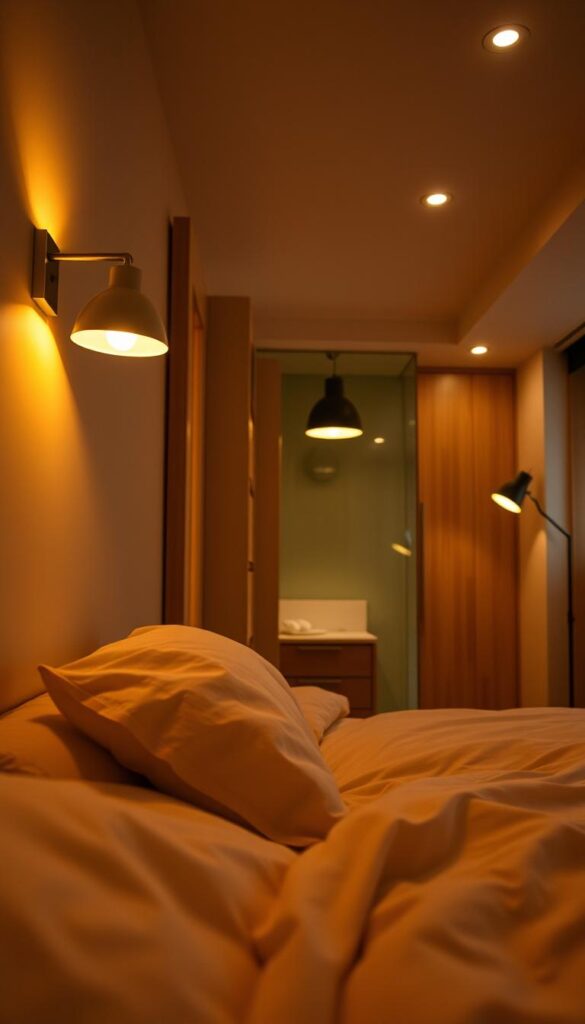
Avoiding a single harsh overhead light is crucial. Instead, I recommend combining multiple light sources to create depth and balance. For example, ambient lighting provides overall illumination, while task lighting focuses on specific areas like a dresser or desk. Accent lighting, on the other hand, highlights key features or adds a decorative touch.
Layering Ambient and Task Lighting
Ambient lighting sets the foundation for a room’s brightness. I often use ceiling fixtures or wall sconces to achieve this. Task lighting, like a desk lamp or a dresser light, ensures functionality in specific zones. For instance, I placed a small lamp on my dresser to make getting ready in the morning easier.
Accent lighting adds the finishing touch. I’ve used LED strips under shelves or behind furniture to create a soft glow. This technique not only enhances the room’s ambiance but also draws attention to architectural details or decor.
Wall Sconces vs. Table Lamps
When space is limited, wall sconces are a game-changer. They free up valuable floor space while providing ample light. I installed sconces above my nightstand, eliminating the need for a bulky table lamp. This approach keeps the floor clear and maintains a streamlined look.
Table lamps, on the other hand, offer flexibility. I use a small lamp on my dresser for added brightness. However, in tighter spaces, wall-mounted options are often more practical. Both choices have their merits, so it’s important to consider your specific needs.
| Lighting Type | Best Use |
|---|---|
| Ambient Lighting | Overall room brightness |
| Task Lighting | Specific areas like desks or dressers |
| Accent Lighting | Highlighting decor or architectural features |
By thoughtfully layering lighting and choosing the right fixtures, I’ve created a bright yet cozy atmosphere in my space. Whether it’s wall sconces or a table lamp, the right lighting can truly elevate the feel of any area.
Creative Storage Ideas to Declutter Your Room
Decluttering a small space doesn’t have to mean sacrificing style or functionality. With the right solution, you can transform even the most cramped area into a tidy and inviting retreat. I’ve discovered that innovative storage ideas can make all the difference, turning clutter into a seamless part of your design.
Under-Bed and Built-In Storage Options
One of my favorite small bedroom ideas is utilizing under-bed storage. This often-overlooked space is perfect for stashing items like seasonal clothing, extra bedding, or shoes. I’ve used rolling bins or drawers that slide easily under the bed, keeping everything accessible yet out of sight. It’s a simple solution that maximizes every inch of your room.
Built-in cabinets are another game-changer. I’ve seen how custom shelves or wardrobes can blend seamlessly into the walls, providing ample storage without taking up floor space. For example, a built-in cabinet near the bed can double as a nightstand, offering both style and practicality.
Here are some additional storage ideas to inspire you:
- Use corner shelves to make the most of awkward spaces.
- Install wall-mounted organizers for accessories like jewelry or scarves.
- Opt for multifunctional furniture, like ottomans with hidden compartments.
Balancing visible storage with hidden compartments is key to maintaining a clean look. I’ve found that open shelves can display decorative items, while closed storage keeps clutter at bay. By combining these elements, you can create a small bedroom idea that’s both functional and stylish.
Expert insights suggest that the right storage solution can transform a cramped space into a haven of order and calm. Whether it’s under-bed storage or built-in cabinets, these ideas can help you make the most of your room without compromising on style.
Selecting Color and Texture to Amplify Your Space
Color and texture are powerful tools to transform the feel of any space. In a compact area, thoughtful choices can make the room appear larger and more inviting. I’ve learned that combining the right hues and finishes can create a sense of depth and warmth, turning limitations into opportunities.
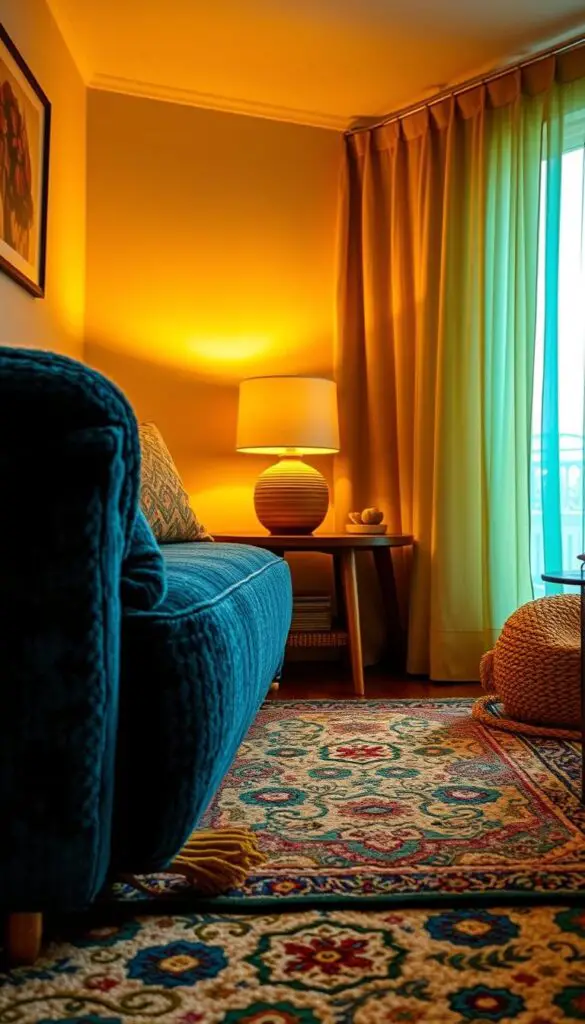
Using Paint and Wallpaper for Depth
One of my favorite bedroom ideas is using paint and wallpaper to introduce depth. For example, a dark ceiling can make the room feel taller, while bold accent walls draw the eye and add character. I’ve also experimented with patterned wallpaper, which creates a cocoon-like ambiance without overwhelming the space.
Light colors are a classic choice for making a room feel airy. I’ve used soft neutrals like beige and light gray to open up my space. Pairing these with textured finishes, such as a woven wall hanging or a textured paint finish, adds warmth and personality.
Balancing Minimalism with Statement Textures
Finding the right balance between minimalism and texture is key. I’ve found that a neutral palette provides a clean backdrop, while textured elements like a plush rug or a knit throw add visual interest. This approach keeps the room feeling open yet cozy.
Lighting plays a crucial role in enhancing these choices. Soft, diffused light can soften harsh contrasts and highlight textures. I’ve used table lamps and wall sconces to create a warm glow that complements the room’s color scheme.
“The right combination of color and texture can make even the smallest space feel expansive and inviting.”
Here are some tips to help you make the most of color and texture:
- Use light colors to create an open and airy feel.
- Incorporate textured finishes for warmth and personality.
- Experiment with dark ceilings or bold accent walls for depth.
- Balance minimal color palettes with statement textures.
- Use strategic lighting to enhance your design choices.
By thoughtfully selecting colors and textures, I’ve transformed my space into a cozy retreat that feels larger and more inviting. Whether it’s a dark ceiling or a textured wall hanging, these ideas can help you make small spaces feel anything but cramped.
Mixing Minimalism with Personal Style
Balancing minimalism with personal flair has been my go-to strategy for creating a space that feels both modern and uniquely mine. A minimalist design doesn’t have to mean sacrificing personality. By carefully selecting streamlined furniture and adding meaningful touches, I’ve crafted a space that reflects my individuality while maintaining a clean, uncluttered look.
One of my favorite ways to add character is through a signature headboard. Whether it’s a bold pattern or a custom design, the headboard serves as a focal point that ties the room together. I chose a textured, oversized headboard that adds warmth and visual interest without overwhelming the space.
Another personal touch is repurposing a vintage desk as a nightstand. This not only adds charm but also provides functional storage. I’ve found that mixing old and new pieces creates a layered, lived-in feel that’s both stylish and practical.
Here are some tips to blend minimalism with personal style:
- Start with a neutral base and add splashes of color through accessories or artwork.
- Choose one or two statement pieces, like a unique headboard or a repurposed desk, to anchor the design.
- Incorporate art and décor that reflect your personality without cluttering the space.
- Use functional furniture that doubles as storage to keep the area tidy.
“Minimalism isn’t about having less; it’s about making room for what truly matters.”
I’ve also embraced the power of color in small doses. A vibrant throw pillow or a piece of abstract art can add energy to the room without disrupting the minimalist vibe. By keeping the majority of the palette neutral, these pops of color stand out and make a statement.
Designers often stress the importance of balance. Too many personal items can create visual clutter, while too little can make the space feel sterile. I’ve found that a few carefully chosen pieces, like a family photo or a handmade vase, can add warmth and personality without overwhelming the design.
| Element | Role in Design |
|---|---|
| Neutral Base | Creates a clean, open feel |
| Signature Headboard | Adds a focal point and personality |
| Repurposed Desk | Combines functionality with charm |
By blending minimalism with personal touches, I’ve created a space that’s both functional and deeply reflective of my style. Whether it’s a bold headboard or a repurposed desk, these elements can transform your area into a place you’ll love.
Incorporating Vertical Storage Elements
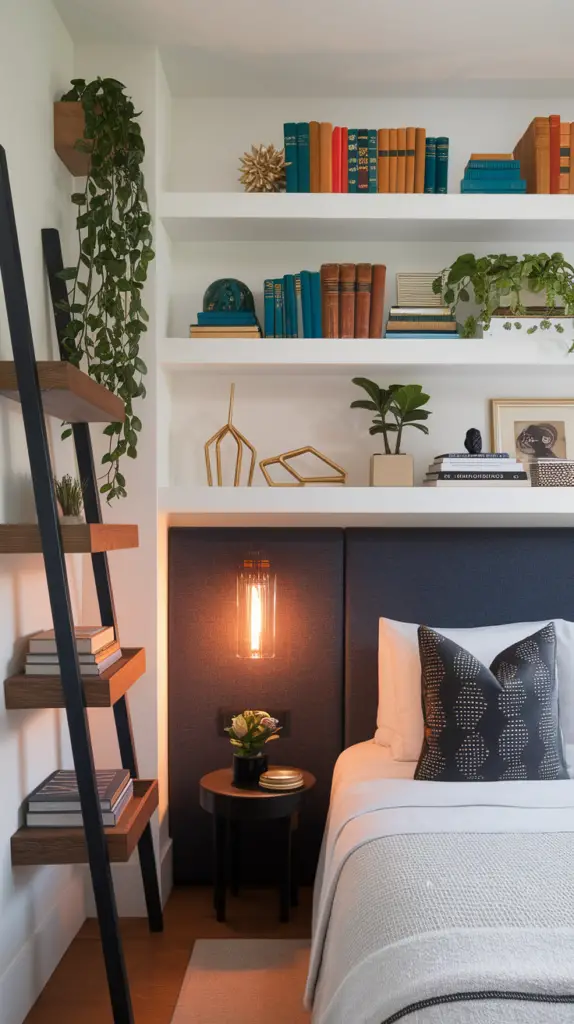
Making the most of vertical space has been a game-changer in my compact living area. By focusing on walls and unused vertical zones, I’ve added both storage and style without cluttering the floor. This approach not only maximizes functionality but also enhances the overall room feel.
One of my favorite solutions is installing high shelves. These shelves not only organize essential items but also serve as a display area for decorative pieces. I’ve used them to showcase books, plants, and artwork, adding personality to the space while keeping it tidy.
High Shelves for Display and Organization
High shelves are perfect for keeping frequently used items within reach while maintaining a clean look. I placed a set of floating shelves above my desk, which now holds my favorite books and a small potted plant. This setup keeps the area functional and visually appealing.
Another benefit of high shelves is their ability to draw the eye upward, making the space feel taller. I’ve paired mine with slim drawers for additional storage. These drawers are perfect for stashing smaller items like stationery or accessories, keeping them out of sight but easily accessible.
Here are some tips for selecting the right shelves:
- Choose shelves that complement your existing furniture to maintain a cohesive look.
- Opt for slim designs to avoid overwhelming the walls.
- Use decorative items like vases or framed photos to add personality.
Built-in units are another excellent option. I’ve incorporated a wall-mounted cabinet with hidden drawers near my bed. This unit doubles as a nightstand, providing both storage and functionality without taking up extra space.
By embracing vertical storage, I’ve transformed my area into a stylish and organized retreat. Whether it’s high shelves or built-in drawers, these solutions can help you make the most of your space while enhancing the room feel.
Choosing Streamlined Furniture for a Cohesive Look
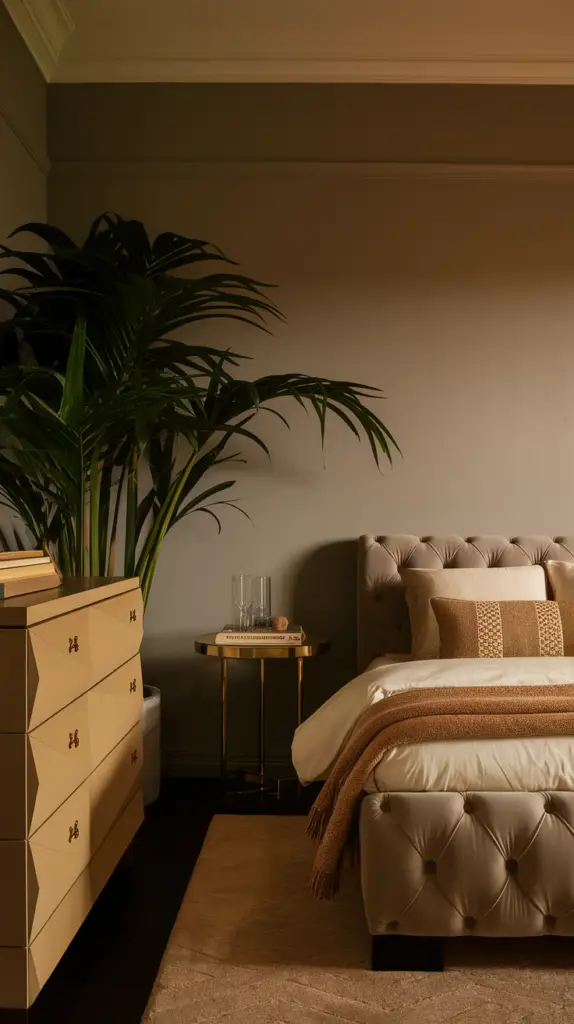
Streamlined furniture can transform even the most compact spaces into a harmonious retreat. When selecting pieces for a small area, it’s essential to focus on scale and functionality. I’ve found that well-proportioned items, like a narrow bedside table or a simple bedding set, contribute to a cohesive design while preserving space.
One of my favorite tips is to avoid bulky, oversized furniture. These pieces can overwhelm the room and make it feel cramped. Instead, I opt for minimal designs that enhance the overall look. For example, a sleek, modern bedside table with clean lines can provide storage without taking up too much room.
Another key consideration is dual-purpose functionality. Every piece of furniture should serve more than one role. I’ve used a storage ottoman as both a seat and a place to stash extra bedding. This approach ensures that the space remains clutter-free and visually balanced.
Here are some examples of furniture that works well in compact areas:
- Narrow bedside tables with built-in drawers.
- Streamlined bedding sets in neutral tones.
- Multifunctional pieces like a desk that doubles as a vanity.
My journey to finding the perfect furniture taught me the importance of balance. By choosing pieces that fit the scale of the room and complement the overall look, I created a space that feels both functional and stylish. Whether it’s a sleek bedside table or a minimalist bedding set, the right choices can make all the difference.
| Furniture Type | Benefits |
|---|---|
| Narrow Bedside Table | Saves space, provides storage |
| Streamlined Bedding | Creates a clean, cohesive look |
| Multifunctional Desk | Combines workspace and storage |
By focusing on streamlined furniture, I’ve transformed my area into a functional and inviting retreat. Whether it’s a narrow bedside table or a simple bedding set, these ideas can help you achieve a cohesive and stylish look in any space.
Smart Layouts for Couples in Small Bedrooms
Sharing a compact space with a partner can be both rewarding and challenging. It’s essential to create a layout that works for both individuals while maintaining a sense of harmony. I’ve found that with thoughtful planning and a bit of compromise, even the smallest area can feel cozy and functional.
One of the first steps is to choose a unified paint scheme. A consistent color palette helps tie the space together, making it feel cohesive. I’ve used soft neutrals like beige or light gray to create a calming atmosphere. Adding a bold accent wall can also inject personality without overwhelming the room.
Compromise and Coordinated Design
When designing for two, compromise is key. Both partners should have a say in the layout and décor. For example, I’ve worked with couples who combined their styles by mixing modern and rustic elements. This approach ensures the space reflects both personalities.
Shared bedside décor is another way to create harmony. Matching nightstands or lamps can unify the look while providing functionality. I’ve also seen couples use wall-mounted shelves above the bed to save space and add a personal touch.
Here are some strategies to consider:
- Choose a multifunctional bed with built-in storage to maximize space.
- Use a unified paint scheme to create a cohesive look.
- Incorporate shared bedside accessories for balance.
- Opt for slim furniture to keep the area open and airy.
Experts recommend selecting pieces that serve dual purposes. For instance, a storage ottoman can double as seating and a place to stash extra blankets. This helps make room feel more spacious and organized.
In my experience, communication is crucial. Discussing preferences and finding common ground ensures both partners feel at home. By blending styles and prioritizing functionality, you can create a space that’s both stylish and practical.
Tips for Budget-Friendly Small Bedroom Design
Designing a cozy space on a budget doesn’t have to be overwhelming—it’s all about creativity and resourcefulness. I’ve discovered that with a little ingenuity, you can transform even the most compact area into a stylish and functional retreat without breaking the bank. Here are some of my favorite budget-friendly tips that have worked wonders in my own space.
Thrift Finds and DIY Upgrades
One of my go-to strategies is shopping at thrift stores. You’d be surprised at the unique treasures you can find, from vintage furniture to decorative accents. I once found a wooden nightstand for just $20 and gave it a fresh coat of paint. Adding textured finishes like chalk paint or distressed details can make it look like a high-end piece.
DIY projects are another great way to save money while adding character. I’ve repurposed old crates into stylish shelves and used fabric scraps to create custom pillow covers. These small touches not only add unique textures but also make the space feel more personal.
Incorporating Built-In Storage
Built-in storage is a game-changer for small spaces. I’ve installed floating shelves above my desk to hold books and decorative items, freeing up floor space. Another built-in solution I love is a wall-mounted cabinet near the bed. It doubles as a nightstand and provides hidden storage for essentials.
If you’re handy with tools, you can create your own built-in units. I built a simple shelf unit with built-in drawers to organize my accessories. This not only saves money but also ensures the design fits your exact needs.
Revamping Existing Furniture
Instead of buying new furniture, consider revamping what you already have. I updated an old dresser by sanding it down and applying a fresh stain. Adding new hardware, like modern knobs, can completely transform its look. This approach is cost-effective and helps make space feel more cohesive.
Decorative Touches on a Budget
Small decorative touches can make a big impact. I’ve used affordable items like string lights, framed prints, and plants to add warmth and personality. A textured wall hanging or a bold accent piece can draw the eye and create visual interest without spending a fortune.
By focusing on thrift finds, DIY projects, and smart storage solutions, you can create a stylish and functional space on a budget. These tips not only save money but also allow you to infuse your personality into the design. Start small, and you’ll be amazed at how much you can achieve!
Conclusion
Creating a functional and stylish space in limited square footage is easier than you might think. Throughout this article, I’ve shared practical strategies to help you maximize every inch of your area. From smart layouts to multifunctional furniture, each tip is designed to enhance your space feel and create a more inviting environment.
Lighting and storage solutions play a crucial role in transforming tight spaces. By layering light sources and incorporating vertical storage, you can make room for both functionality and style. These small changes can have a big impact, turning even the most compact area into a haven of comfort.
I encourage you to experiment with these ideas and adapt them to your unique needs. Whether it’s a clever layout or a dual-purpose piece of furniture, the right approach can truly transform your space. With a little creativity, you can achieve a cohesive design that feels both spacious and personal.
Remember, the key is to focus on what works best for you. By implementing these tips, you’ll not only make room for functionality but also create a space that reflects your personality. Start small, and you’ll be amazed at how much you can achieve!

